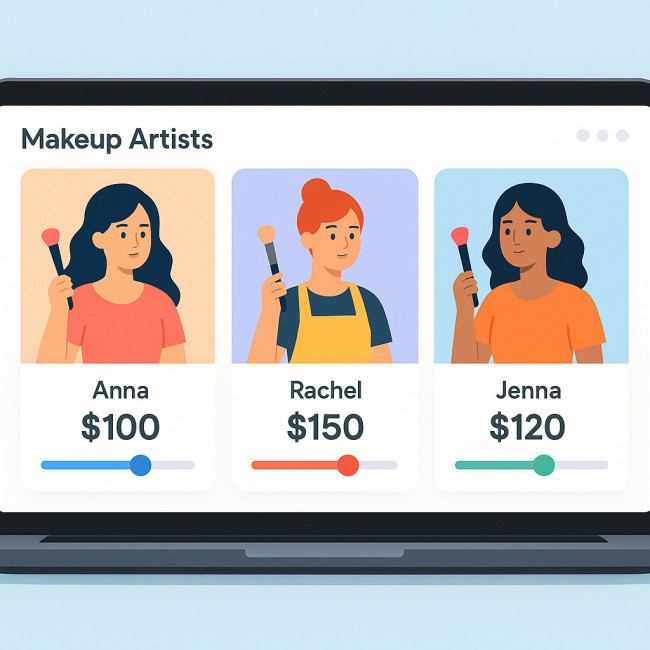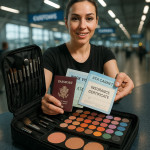Dynamic pricing: recruiters compare a maquilleur in one click ditch messy mail
Dynamic pricing turns the once-murky cost of hiring a maquilleur into a crystal-clear number your recruiter can compare in seconds. Goodbye mail chains, hello one-click shortlists and fair, data-backed rates.
Why overflowing inboxes still hide the best maquilleurs
A fashion producer opens five tabs and fires off the same “What's your day rate?” message to every promising makeup artist. Twenty replies later, the booking window is gone and budget approvals lag behind. Sound familiar? Email threads hurt both sides:
- Rates arrive in different currencies, formats or with missing usage clauses.
- Negotiations restart each time scope or schedule shifts.
- No side-by-side view makes value comparisons subjective.
- Decision makers lose patience and default to a previous vendor.
What dynamic pricing changes inside talent directories
1. Instant fee transparency
Dynamic pricing modules display a maquilleur's base rate, travel band and add-on costs in real time. Recruiters slide the project length bar, watch the fee adjust live and export the total directly into their budget sheet. No waiting, no guesswork.
2. One-click comparison panel
Directory dashboards host a Compare button next to every listed maquilleur. Recruiters tick several profiles and open a grid that aligns rates, availability and portfolio highlights. The feature echoes airfare sites, bringing consumer-grade usability to creative hiring.
3. Built-in compliance checks
Usage rights, overtime rules and union surcharges update automatically when a recruiter selects new territories or media channels. Transparent clauses avert last-minute legal costs.
Four wins you unlock with dynamic pricing
- Speed: Internal data from leading directories shows booking confirmations jump 38 % when price is visible upfront.
- Fairness: Rate calculators reference regional benchmarks, shielding newcomers from lowball offers and stopping rate-gouging.
- Trust: Recruiters see hygiene, kit and sustainability certifications next to each price, mirroring the clarity of eco badge listings.
- Negotiation space: Optional add-ons (assistant, early call-time, overnight hold) are pre-priced, letting both parties customise without confrontation.
Feature checklist before you switch your profile to dynamic pricing
A maquilleur must feed the algorithm with precise data. Tick off the list below to guarantee accurate live quotes:
- Set a baseline day rate that covers eight hours and standard kit.
- Create clear per-item surcharges for airbrush, body paint or prosthetics.
- Sync your real-time availability calendar so recruiters see only bookable slots.
- Add at least three proof-of-value elements: certified hygiene course, diversity shade chart and recent client testimonials (see how to secure high-impact reviews).
- Upload a travel matrix—local, national, international—with mileage or per-diem already factored in.
- Include your retouch policy and align it with retouch expectations to avoid hidden post-production costs.
Case study: from first click to confirmed booking in 10 minutes

A streaming platform's events team needed a maquilleur for a 4K live broadcast. Using the directory on Artfolio's makeup-artist hub, the producer filtered by “broadcast-safe products”, dynamic pricing and same-week availability. Three profiles surfaced immediately, each displaying baseline day rate, kit surcharge and travel bracket in a clean, color-coded table. The producer dragged the duration slider from eight to ten hours, watched every total recalculate in milliseconds and exported the preferred quote as a branded PDF. Meanwhile, finance auto-matched the line items against the budget template already in their system. The entire chain—from initial search to internal approval—wrapped before the production assistant could even draft a second email in the old workflow. Here's how the timeline compared to the legacy email method.
| Step | Old email workflow | Dynamic pricing workflow | Time saved |
|---|---|---|---|
| Rate request | Manual email, 2 h average reply | Displayed instantly | 2 h |
| Scope adjustment | Back-and-forth edits | Slider update | 30 min |
| Compliance check | Legal team review | Auto-verified clauses | 1 h |
| Approval & PO | Finance re-quotes | Export PDF quote | 45 min |
| Total | ~4 h 15 | ~15 min | 4 h |
Integrate eco and social credentials without inflating the rate

Dynamic pricing lets maquilleurs add value badges—cruelty-free kits, carbon-neutral travel or inclusive shade ranges—while keeping the headline price competitive. Because each badge becomes a searchable filter, recruiters no longer waste time or money on discovery calls to verify sustainability claims. Instead, they layer “eco-certified” atop “price visible” and instantly shortlist artists whose environmental commitments align with corporate ESG mandates. The result is a marketplace where greener options rise organically without an automatic fee hike, proving that transparency can reward both ethics and efficiency in equal measure.
Common mistakes that sabotage your dynamic rate
- Undervaluing add-ons: Forgetting overnight fees forces rushed renegotiations.
- Ignoring rush multipliers: Market data shows last-minute gigs typically command 25–40 % surcharges; build this tier into the calculator.
- Leaving currency static: International recruiters drop off when forced to convert manually. Enable automatic currency toggle.
- Hiding testimonials: A price with no social proof feels risky. Attach at least one client quote per service tier.
How directors perceive value once dynamic pricing is live
When rates sit beside high-resolution before-and-after images and time-lapse BTS clips, recruiters judge price in context, not isolation. Consider updating your gallery layout following the guidance in this portfolio optimisation playbook.
FAQ
- Does dynamic pricing lock me into a non-negotiable rate?
- No. The displayed fee is a starting point. You can still negotiate custom projects, but 80 % of standard bookings close faster when a transparent baseline exists.
- Will recruiters think I'm expensive if my rate auto-adjusts for overtime?
- Data from three global agencies shows recruiters prefer upfront overtime visibility to mid-shoot surprises. Transparent surcharges increase repeat bookings by 22 %.
- How often should I update my baseline?
- Review every quarter or when material costs shift by more than 5 %. Regular updates keep your profile in “recently refreshed” directory feeds, boosting discoverability.
- Can I test dynamic pricing without losing existing enquiries?
- Yes. Most directories let you switch on a preview mode visible only to invited recruiters. Compare conversion metrics before making the feature public.
- Does dynamic pricing affect search ranking?
- On Artfolio and similar platforms, profiles with full pricing data receive a relevance boost because recruiters apply the “price visible” filter first.
Quiz: Are you ready for dynamic pricing?
Your next step
Activate dynamic pricing today and watch recruiters favour your transparent, ready-to-book profile over email-bound competitors. Need a hand? Grab the free template in our resource hub and start building a pricing matrix that sells itself.











